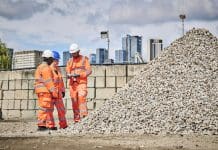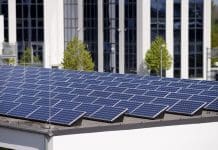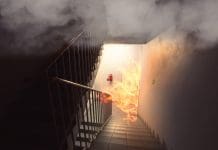Concrete is increasingly recognised in the delivery of the most sustainable projects. Here, PBC Today outline the role of specifiers in this process
Concrete as a material is incredibly versatile and offers many opportunities for designers to influence the environmental, economic and social credentials of their projects, including performance credentials such as fire resistance, thermal mass, acoustic performance and flood resilience. Add this together with a reduced need for applied finishes, and concrete is increasingly recognised and utilised by design teams in the delivery of the most sustainable projects.
Speaking at the Ecobuild event on 7 March, Elaine Toogood – Senior Architect at The Concrete Centre presented a seminar on Sustainable Concrete and pointed out that:
“The inherent benefits of concrete mean it does not need any other treatment to make it perform, to make it fireproof. This, and many of the other performance benefits of concrete are often not discussed as sustainability benefits, and they should be.”
The whole-life performance
Sustainability is largely about getting the fabric right. Using the thermal mass of concrete within a natural ventilation strategy can reduce the amount of energy required for heating and cooling, therefore reducing the total amount of energy we use in a building. But that’s not the whole story. Examining the whole-life performance is also a key part.
Understanding the impact that different design choices have on the whole-life of a building is key. The emphasis is shifting between embodied and operational impacts, but the best answer needs to consider the lifecycle of the building’s components and materials and their contribution to minimising the overall impact over the whole-life of a building.
Concrete comes in a whole variety of forms including off-the-shelf precast products, cast in situ concrete, bespoke precast or hybrid concrete solutions. If you’re a specifier you are able to assess the manufacturers product data and going forward this is more and more likely to be in the form of an EPD (Environmental Performance Declaration). Manufacturers will provide EPDs specific to their product range and the concrete industry is developing generic EPDs that are useful at the early stages of a project.
Reducing carbon
The industry is doing an enormous amount to reduce its carbon footprint, but specifiers also have a role to play here by stipulating they want lower carbon forms of concrete. Elaine Toogood, again speaking at Ecobuild this year commented:
“We as specifiers can request concrete mixes with a lower carbon footprint, such as those using cementituous materials that include fly ash or ground granulated blast-furnace slag (GGBS).” GGBS is a by-product recovered from the blast furnaces used in the production of iron, and fly ash is a by-product of coal-fired power stations. By using these materials, the overall greenhouse gas emissions associated with the production of concrete is reduced, and you can make serious reductions in a project’s embodied carbon footprint.
New standards and guidance
At present it is common practice in Britain to use cement combinations with either fly ash or GGBS (used with Portland cement). Other cement combinations are also allowed within BS 8500 including those using silica fume and limestone.
The concrete industry is currently coordinating an investigation on the use of finely ground limestone as part of ternary or three component cements, also including fly ash or GGBS. The aim is for this to be introduced into the concrete standard for the UK (it is already permitted in Ireland and other European countries).
There is a great deal of research going on in the background for alternative types of cements. The standard produced last year: PAS 8820:2016 Construction materials was developed allowing the use of alkali activated cements (AAC) in some concrete applications.
Recycled aggregates
In the drive to remain sustainable it is worth considering the use of recycled aggregate in the concrete specified for a project. When specifying recycled aggregate to reduce embodied carbon, it is important to check what is available locally to the site. Natural aggregates have such a low carbon footprint that a source of recycled aggregates traveling more than around 15km by road is likely to have higher embodied carbon than a local supply of natural aggregate.
Another factor when using recycled aggregates is consistency of supply. There are strict protocols for the testing of aggregates for use in concrete, and there are permitted quantities of recycled aggregate, depending upon the type as well as the strength and exposure class of the concrete being designed.
It’s important to bear in mind that there are also various secondary aggregates that are classed as a type of recycled aggregate for use in concrete. These are by-products of other industries and include china clay waste from the South West of England, often referred to as stent.
Material efficiency
Elaine went on to explain how concrete offers the opportunity for material efficiency, urging designers to use the performance benefits of concrete and optimise its use by considering low waste solutions and efficient design as a way to reduce the amount of other materials needed in the construction.
“Unlike many other materials, a concrete structure can provide a good, robust finish without the need for additional coatings or linings to provide the necessary long life performance, fire resistance or acoustic isolation necessary to meet building standards. The savings on resources to install and repair these finishes can add up to significant material savings over the lifetime of a building.”
“This whole life perspective is crucial if we are to move towards a circular economy.” explains Elaine. “A good approach is to design a building that can be used and then reused, extending its usable life and thereby save resources. This can add up to a low whole-life carbon solution.”
Concrete is often designed to last for 100 years at no extra cost, offering plenty of opportunity for an extended service life of a building or structure. Furthermore, when the time eventually comes to demolish it, concrete can be crushed and reused.
“At the point it’s crushed up, it actually starts absorbing CO2 due to the extra surface exposed to the air. This end of life carbonation is fairly new to our understanding, but can make an impact of the whole-life carbon profile of a building.”
Specify responsibly sourced concrete
Responsible sourcing for construction materials is a similar concept to Fairtrade standards for food. Elaine Toogood told the audience at Ecobuild that:
“BES 6001 is a responsible sourcing standard available for all construction materials and is the one the concrete industry has embraced. Around 90% of all concrete produced in the UK is responsibly sourced to BES 6001. This is quite an achievement, but of course facilitated by the fact that unlike most other structural materials concrete is almost always made in the UK from UK sourced materials. This is a fundamental sustainability benefit, underpinning the core social, economic and environmental credentials of concrete for use in a sustainable built environment.”
Further reading is available on the Concrete Centre website including the Whole-Life Carbon and Buildings and Specifying Sustainable Concrete documents.
PBC Today
Tel: 0843 504 4560
info@pbctoday.co.uk













